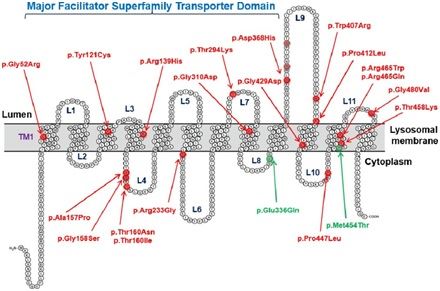Introduction of MFSD8
Major facilitator superfamily domain-containing protein 8 (MFSD8) is also known as Ceroid-lipofuscinosis neuronal protein 7 (CLN7), which is responsible for neuronal ceroid lipofuscinosis 7 (NCL7) in humans. Neuronal waxy lipofuscinosis (NCLs) is a group of hereditary, neurodegenerative diseases characterized by chromosomal recessive and lysosomal accumulation. It is mainly caused by enzyme deficiency or transmembrane protein deficiency, leading to the accumulation of lipids in various tissues. At least 13 genetic forms are currently recognized (CLN 1-8 and CLN 10-14); all diseases except for CLN4 are recessive. Mutations in the MFSD8 are found to be the basis for the late-infant NCL (vLINCL). MFSD8 gene encodes putative lysosomal transporter MFSD8 with a topology of 12 transmembrane domains, showing its localization to the lysosomal membrane. MFSD8 has a specific lysosomal sorting motif and two N-glycosylation sites, and it is inactivated by proteolytic cleavage.
| Basic Information of MFSD8 | |
| Protein Name | Major facilitator superfamily domain-containing protein 8 |
| Gene Name | MFSD8 |
| Aliases | Ceroid-lipofuscinosis neuronal protein 7 |
| Organism | Homo sapiens (Human) |
| UniProt ID | Q8NHS3 |
| Transmembrane Times | 12 |
| Length (aa) | 518 |
| Sequence | MAGLRNESEQEPLLGDTPGSREWDILETEEHYKSRWRSIRILYLTMFLSSVGFSVVMMSIWPYLQKIDPTADTSFLGWVIASYSLGQMVASPIFGLWSNYRPRKEPLIVSILISVAANCLYAYLHIPASHNKYYMLVARGLLGIGAGNVAVVRSYTAGATSLQERTSSMANISMCQALGFILGPVFQTCFTFLGEKGVTWDVIKLQINMYTTPVLLSAFLGILNIILILAILREHRVDDSGRQCKSINFEEASTDEAQVPQGNIDQVAVVAINVLFFVTLFIFALFETIITPLTMDMYAWTQEQAVLYNGIILAALGVEAVVIFLGVKLLSKKIGERAILLGGLIVVWVGFFILLPWGNQFPKIQWEDLHNNSIPNTTFGEIIIGLWKSPMEDDNERPTGCSIEQAWCLYTPVIHLAQFLTSAVLIGLGYPVCNLMSYTLYSKILGPKPQGVYMGWLTASGSGARILGPMFISQVYAHWGPRWAFSLVCGIIVLTITLLGVVYKRLIALSVRYGRIQE |
Function of MFSD8 Membrane Protein
Pathologically, MFSD8 contributes to neuronal waxy lipofuscinosis (NCLs), which display an accumulation of autofluorescent storage material in neurons and neurodegeneration. NCLs causes some impaired end-organ function, including cognitive and motor function loss, myoclonus, and the central nervous system of intractable seizures. Mutations in MFSD8 are found to cause a variant of late-infantile NCL (vLINCL,). The vLINCL is genetically heterogeneous and five major potential genes have been identified to date. The NCL7 disease produced by mutations in the MFSD8 gene has a fairly homogeneous phenotype, with 15% patients having an atypical episode or long course of disease; the onset usually occurs between 2 and 11 years (mean onset is 5 years), and the clinical manifestations of late infants include motor and cognitive decline, seizures, visual loss, ataxia. MFSD8 shows a high frequency of mutations that are expected to result in abnormal gene product expression (78.6%).
 Fig.1 The topological prediction plot of MFSD8 shows the location of the pathogenic missense mutation. (Khan, 2017)
Fig.1 The topological prediction plot of MFSD8 shows the location of the pathogenic missense mutation. (Khan, 2017)
Application of MFSD8 Membrane Protein in Literature
This article discusses the prospects of (neuronal ceroid lipofuscinosis) NCL gene therapy, particularly those that can systematically deliver and treat brain and peripheral tissues.
This article shows that aggregation-dependent disruption of ALP function is a relevant pathogenic mechanism of AD-ANCL, and the use of AFSM or CSPα aggregation is a biomarker for drug screening purposes.
The study provides a gene therapy strategy for the treatment of neurogenetic diseases through the use of the CRISPR/Cas9 system.
This article reinforces the neuroprotective effects of gemfibrozil, which may have therapeutic implications for improving the quality of life of patients with LINCL.
This article reveals that multifocal myoclonic jerks and seizures are a key feature in the patients with neuronal ceroid lipofuscinoses, but myoclonic seizures are an early and prominent sign in the teenage/adult form only and the childhood-onset form is characterized by initial and severe cognitive impairment coupled with electroretinogram and EEG attenuation.
MFSD8 Preparation Options
Membrane protein studies have advanced significantly over the past few years. Based on our versatile Magic™ membrane protein production platform, we could offer a series of membrane protein preparation services for worldwide customers in reconstitution forms as well as multiple active formats. Aided by our versatile Magic™ anti-membrane protein antibody discovery platform, we also provide customized anti-MFSD8 antibody development services.
During the past years, Creative Biolabs has successfully generated many functional membrane proteins for our global customers. We are happy to accelerate the development of our clients’ programs with our one-stop, custom-oriented service. For more detailed information, please feel free to contact us.
Reference
All listed services and products are For Research Use Only. Do Not use in any diagnostic or therapeutic applications.